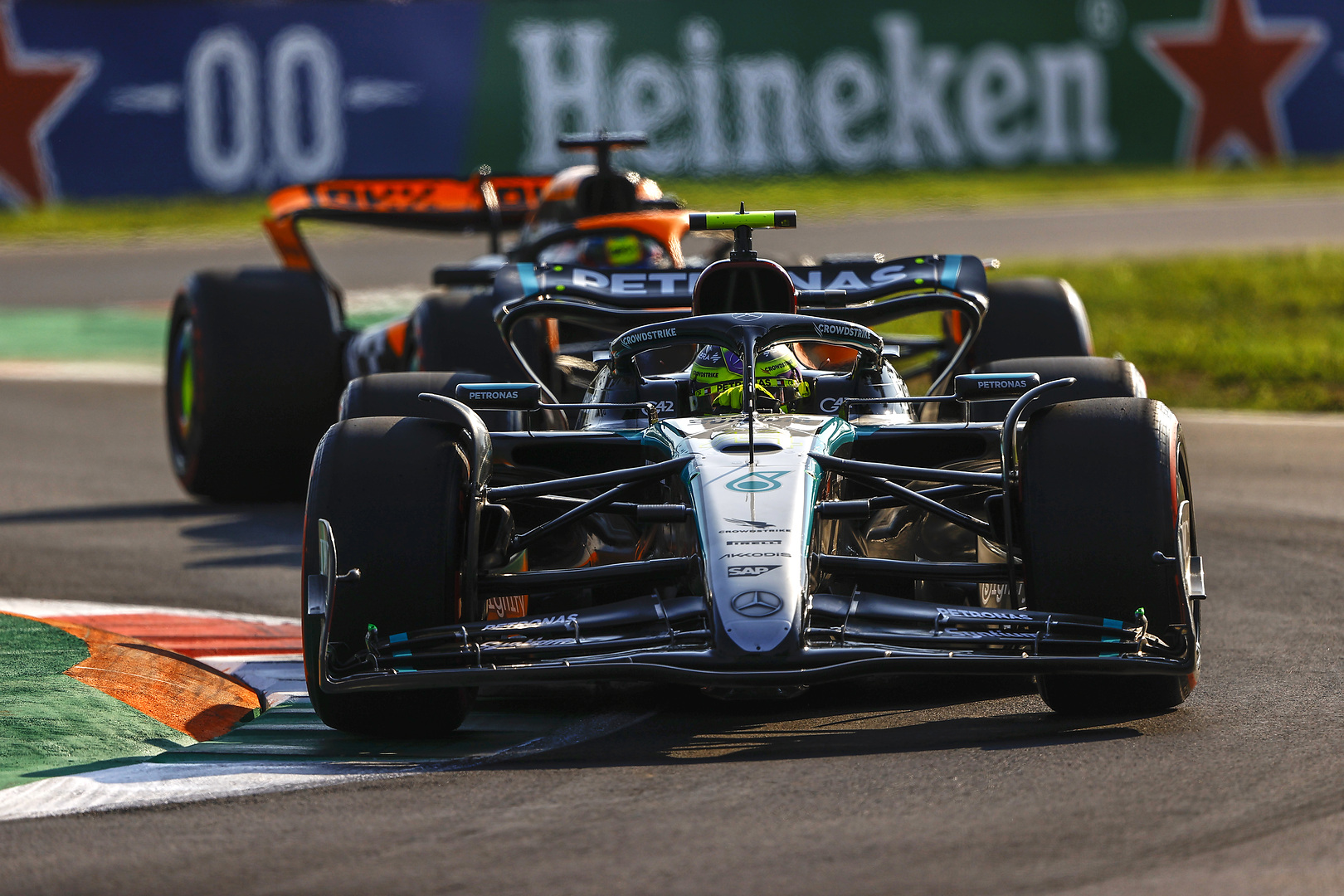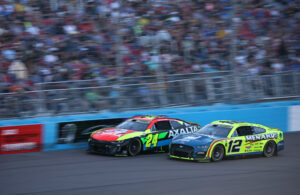FIA respond to “illegal” Mercedes and McLaren front wings allegations.
Onboard footage from last weekend’s Monza race has heightened suspicions. Concerns focus on the legality of Mercedes and McLaren’s front-wing designs. There seemed to be a greater degree of motion within the wing designs, which Ferrari and Red Bull flagged up. Both teams appeared to seek clarification on how much they could exploit flexi-wings.
Speculation has arisen about whether McLaren’s pace increase since 2023 is due to this exploitation. The British team has caught up to Red Bull on track. They now have a clear path to the Drivers’ and Constructors’ titles.
McLaren continue to close the gap to Red Bull 👀#F1 #ItalianGP pic.twitter.com/hy9tDp9dDk
— Formula 1 (@F1) September 1, 2024
While their strategy mishaps and Norris’ poor starts let them down on race weekends, they also have the fastest car. This has led to room for scrutinization of their front wing.
Fastest lap, on the fastest track 🚀
Ride on board with @LandoNorris for his pole position lap in Monza 🇮🇹#F1 #ItalianGP @pirellisport pic.twitter.com/Ykmg9soTln
— Formula 1 (@F1) August 31, 2024
Mercedes has thoroughly improved in the 2024 season. The German team’s performance shows significant progress compared to the previous two years in F1. They have won three Grands Prix thus far. However, this could be due to the return of Technical Director James Allison. Allison was instrumental in five of Mercedes’ Constructors’ Championships and four Drivers’ titles from 2017.
Since the Belgian Grand Prix, the FIA has monitored the movement of front wings with cameras. This aimed to help them assess whether the current flex tests are suitable and need revision.
The organisation have been clear in the fact that this was for data-gathering purposes. It was not an inquest into teams, such as Mercedes and McLaren, who may require punitive measures for their designs.
When the FIA introduced these additional checks, they stated that any unjust findings would not lead to regulatory changes. Regulations will remain unchanged this season. Any necessary rule changes would likely be introduced as early as 2025.
And now, the FIA has confirmed that all 2024 F1 front wings are legal and have shown to be compliant with the governing body’s tests.
Grid Thoughts
Red Bull motorsport advisor Helmut Marko told the Austrian broadcaster ORF after qualifying at the Italian Grand Prix that:
“The front wing of McLaren and Mercedes must be analysed.”
While Marko demanded further clarification, Red Bull team principal Christian Horner explained that he had to trust the FIA over the matter:
“I think the regulations are very clear and that’s an FIA issue. Obviously they are tested and they pass, but then you have to look at the wording of the regulations.
“But, if you remember back in ’21, certainly around Baku time, there was a change to the front wing regulations, even though our wings passed the test [at the time]. It’s an FIA issue, so we’ll leave it and trust in them to deal with it.”
When asked whether the FIA’s clarification that Mercedes and McLaren’s designs were allowed would prompt Red Bull to pursue similar ideas, Horner said:
“Well, if it’s acceptable then you have to join in.”
The Austrian team have experienced a fall from grace this season. What originally looked to be another season of dominance for them has turned into a competition for both the Drivers’ and Constructors’ Championships.
Their car development has also not been smooth, which has led to complaints from drivers Max Verstappen and Sergio Pérez.
Following Red Bull’s interest in the Flexi-wings of their rivals, Ferrari team principal Fred Vasseur said:
“This is a discussion that I don’t want to have with you, I will have it with Tombazis.
“But we have to respect the decision of the FIA. We will have, again, the discussion…”
“We have to deal [with] it internally with the FIA.”
FIA Statement
The FIA’s statement about the 2024 F1 wings reads as follows:
“The FIA is examining front wings at every event with numerous checks (conformity of surfaces, conformity of deflections) with respect to the relevant F1 Technical Regulation. All front wings are currently compliant with the 2024 regulations.
“Since the Belgium Grand Prix, the FIA has acquired additional data during FP1 and FP2 sessions to assess dynamic behaviours through an FIA-mandated video camera which captures areas of the front wing which are not visible through the official FOM cameras.
“This exercise will continue at least up until Singapore to ensure every team will have been running the mandated FIA camera on different types of tracks (low, medium, high and very high downforce).
“This will ensure a large database allowing the FIA to draw the most objective picture of the situation and quantify differences between the various dynamic patterns observed on track.”
It also adds that “no component is infinitely stiff” and this sets the provision for a small amount of flex under a given load. Article 3.15.5 in the 2024 technical regulations states that “the trailing edge of any front wing flap may deflect no more than 5mm when a 60N point load is applied normally to the flap and measured along the loading axis.”
With this, the FIA added that:
“the front wing has been a challenging area throughout the years, because the aerodynamic loading patterns between different competitors varies and it is therefore difficult to find a load vector which will cover all types of front wing construction.
“Other areas of the car – including rear wing and floor edges – have much more consistent aerodynamic loading patterns across the grid, making for a more universal load-deflection test.
“The FIA has the right to introduce new tests if irregularities are suspected. There are no plans for any short-term measures, but we are evaluating the situation with the medium and long-term in mind.”
Technicality
FIA regulations have established how static loads will be applied to wings to ensure compliance with this season’s rules. This is how they have tried to control teams’ chances of exploiting aerodynamic elasticity.
Despite this, teams know that as long as their wings pass the tests in the garage, they can emphasize extra flexibility on the track.
For instance, Mercedes shared that their front wing featured more flexible elements. James Allison explained that teams all knew where the boundaries were. With this, it was up to each team to decide how far they would take their exploitation and designs.
There should have been an emphasis on passing the FIA’s flexibility test as wings should not have moved by more than a specified amount but if a team could do that successfully then there would be no drama to face with the governing body.
However, a line should have been drawn between wings that naturally flexed at load and those that were specifically designed to behave in a desired way at set speeds. Allison believes:
“I don’t think it would be legit to have a thing that does stuff at given speeds,” he said.
“I think something that just bends the more load you put on it, that is what all materials do. So I think that’s the playground most people are in.”
This seemingly was a correct take. Mercedes and McLaren have legal wings, so if their designs offer an advantage, teams like Red Bull and Ferrari might want to adjust accordingly while they still have the chance.
Conclusion
A technical directive from the FIA (TD34) emphasized that certain behaviours would not be accepted by design if wings passed as legal in the pits during testing.
The FIA will reject designs that alter their structural characteristics through secondary parameters aimed at producing a different deflection characteristic not present during stationary checks. Examples of these secondary parameters include temperature and aerodynamic load.
With the FIA approving Mercedes and McLaren’s 2024 F1 front wings, Red Bull and Ferrari must consider if adapting their own is worthwhile.






